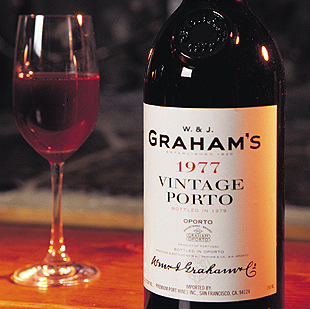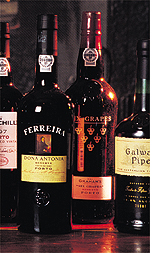

Photo by David N. Seelig
Port
Pure winter pleasure
By Gregory
Foley
Evelyn Waugh, the renowned British author of “Brideshead Revisited,” once said: “Port is not for the very young, the vain and the active. It is the comfort of age and the companion of the scholar and the philosopher.”
Indeed, in 20th century Britain, port was to a large extent revered as the elixir of the sophisticated, a complex after-dinner beverage that should be enjoyed fireside amid conversations about Socrates and Descartes.
Here in the United States, the mere mention of port decades ago would likely conjure up images of elderly professors sniffing and swirling glasses of rich, amber-colored wine as they analyzed high society.
In recent decades, however, port has increasingly shed its image as a beverage reserved for the upper crust. Across the United States, it has found its way onto more and more wine lists, and into the hearts of more and more wine drinkers who enjoy its warm, comforting qualities, particularly in cooler seasons.
“It’s so warm, it’s so luscious, it’s so filling,” said Craig Spiller, manager of Sun Valley Wine Company in Ketchum. “It’s when you’re in an easy chair with your feet up. It’s after dinner. It’s when it’s cool outside. It’s when you need a pick-me-up and you just want to feel relaxed in a general sense. Port does the trick.”
Mark Ervin, account representative for Ketchum-based J. W. Thornton Wine Imports, said port is still a classic after-dinner digestif, but today can be easily enjoyed without pretense. Most ports, he said, are best served after dinner, or with a cheese course.
“It’s a dessert unto itself,” Ervin said. “It’s mind blowing how good it can be.”
Port is truly a wine like no other. It is rich, aromatic and remarkably flavorful. High in alcohol and sugar, it is also warming and sweet. And, notably, it is steeped in history.
Port originated in the Douro Valley of northeast Portugal, on the rugged hillsides above the Douro River.
For centuries, the people of the Douro produced large quantities of rich, dry table wines craved by nobles. In the 17th century, when political strife surfaced between England and France, the English sought to import greater quantities of wines from Portugal. Soon, they discovered that the wines from the Douro could successfully substitute for fine French wines.
Eventually, small quantities of brandy were added to the Douro wines to preserve them for shipment. Then, in 1820, when a particularly ripe vintage produced wines that were exceptionally sweet and rich, the English found it irresistible. Soon, producers started fortifying their wines with greater amounts of brandy to emulate the prized 1820 vintage.
Today, port is still a sweet, fortified wine prized by the English. Yet, in the late 20th century, Americans started to increasingly discover the splendor that is fine port.
“Americans talk dry but they drink sweet,” Ervin said. “Port is not only sweet, the quality is extraordinarily high.”
Port-style wines are made all over the world, but true port, or Porto as it is labeled in the United States, must come from Portugal.
The sweetness tasted in true Porto wine is the result of a unique winemaking process in which a fortifying spirit is added during fermentation of the crushed grapes. The fortification arrests fermentation, leaving in the wine a measure of unfermented sugars and a relatively high percentage of alcohol, generally about 20 percent.
Porto comes in two broad categories, fortified wines brought to maturity through either cask aging or bottle aging.
Vintage Portos, the most expensive style of port, are wines from a single harvest of exceptional quality. They are profoundly rich in color, aroma, flavor and longevity.
 Photo
by David N. Seelig
Photo
by David N. Seelig
The vintage wines spend two to three years in wood casks and are then transferred to bottles for additional aging, for 20, 30 or more years. The 1990s were an exceptional decade for vintage Portos, with 1991, 1992, 1994 and 1997 all producing outstanding wines.
The major styles of cask-aged Portos include ruby, tawny, vintage character and late-bottled vintage, as well as aged tawnies. These wines are generally ready to drink upon release.
Ruby Porto, appreciated for its rich flavors and fruity aromas, is created by blending young, cask-aged wines from numerous harvests.
Standard tawny Porto is a blend from lighter wines that exhibits a soft color and elegant flavors.
Vintage-character Porto, offered by most of the large Porto houses under unique proprietary names, such as Graham’s “Six Grapes,” is a premium ruby-style wine that emphasizes richness and fruit flavors.
Late-bottled vintage Porto is a wine from a single year, most often years that are not declared exceptional enough to make “vintage” wines. They are aged in wood for four to six years before bottling.
Aged tawny Portos are made from high-quality wines from different vintages that have spent considerable amounts of time in wooden casks. The average age of the wine, typically 10, 20, 30 or 40 years, is indicated on the bottle. Tawny in color, they offer layers and layers of delicate flavors that hint of caramel and nuts.
Although Portugal clearly leads the industry, an increasing number of quality port-style wines are coming from other nations, including Australia and the United States.
Spiller said few things can provide a dose of comfort and warmth like a glass of port, whether it be from Portugal or Australia.
“Port has such richness, thickness and length on the palate,” he said. “It’s the type of thing you can sip and it just sits with you.” •









